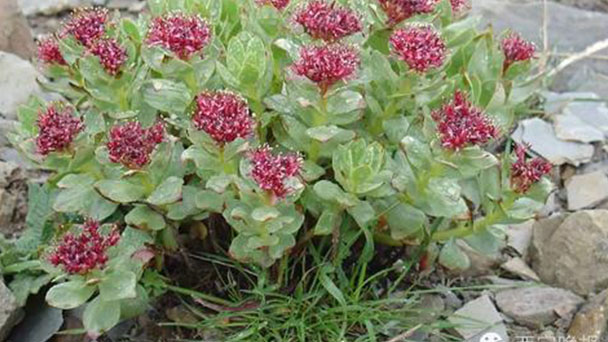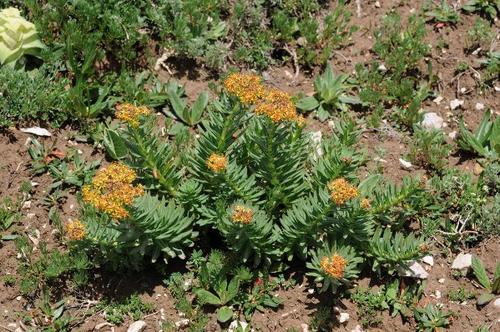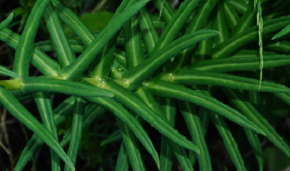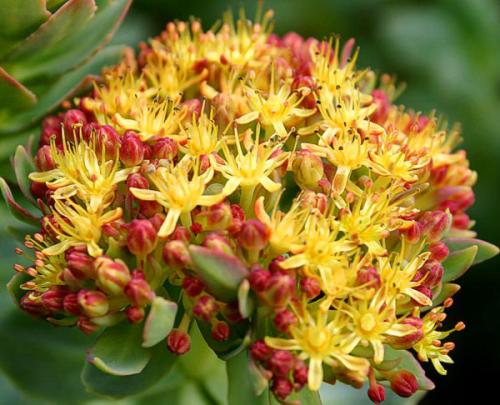Rhodiola kirilowii profile
Written by Maggie
Mar 26 2021

Rhodiola kirilowii belongs to the family Sedum Sedum perennial fleshy herbs. Roots are thick, erect. Rhodiola kirilowii is produced in Tibet, Yunnan, Sichuan, Xinjiang, Qinghai, Gansu, Shaanxi, Shanxi, Hebei. Rhodiola kirilowii was born 2000-5600 meters above sea level on the rocky mountain grassland or stone slope.
Rhodiola kirilowii picture

Morphological characteristics of Rhodiola kirilowii
Rhodiola kirilowii is a perennial herb. Roots are thick, erect. Root neck is 1, 5cm in diameter, apex triangular-scaled. Flower stems are few, 15 -- 60cm tall, a few to 90cm, 4 -- 6mm in diameter, leaves dense. Leaves are alternate, linear to linear-lanceolate, 4 -- 6cm long, 2 -- 5mm wide, apex acute, margin sparsely serrate, or sometimes entire, sessile.
Inflorescences of Rhodiola kirilowii are corymbiform, multi flowered, 7 -- 10cm wide; Sepals 5 or 4, triangular, 2 -- 2.5mm long, apex acute; Rhodiola kirilowii has 4-5 petals, greenish-yellow, oblanceolate, 3 -- 4mm long, 0.8mm wide; Stamens 10 or 8 in male flowers, as long as petals or slightly beyond, filaments, anthers yellow; Scales 5 or 4, subsquare or oblong, 0.8mm long, apex obtuse or emarginate; Carpel 5 or 4, erect. Follicles are lanceolate, 7 -- 8mm long, with a short, outwards curved beak; Seeds of Rhodiola kirilowii are oblong-lanceolate, 1.5mm long.
Ecological habits of Rhodiola kirilowii
Rhodiola kirilowii is grown in the snow-covered plateau at an altitude of 3000-4500m, where the growing environment is high and cold, with low oxygen and strong ultraviolet radiation. It contains a variety of active ingredients and a high content. Because Rhodiola kirilowii likes cold and dry climate conditions, it is cold and drought-resistant, and the soil requirements are not strict.
The distribution of Rhodiola kirilowii
Rhodiola kirilowii distributes in Xizang, Yunnan, Sichuan, Xinjiang, Qinghai, Gansu, Shaanxi, Shanxi, Hebei.Born in the elevation of 2000-5600m mountain stony grassland or stone slope. Burma also has it. The type specimens were collected from Baihua Mountain, Beijing.
Sowing propagation of Rhodiola kirilowii
Seed in time to seed after drying in a timely manner, to prevent the occurrence of seed opening sprouts, sowing artificial injury sprouts phenomenon, affect the emergence of seedlings.Because Rhodiola kirilowii seeds are very small (about 0.3g per thousand seeds), it is necessary to add fine volcanic sand or river sand in a certain proportion (such as 1:100 or 1:150) during sowing. After stirring evenly, the seed amount per mu of seedling field is divided into 5-10 equal parts and spread evenly on the bed surface. The sowing amount per 667m2 is about 0.5kg.

Disease control of & pest Rhodiola kirilowii
The prevention and treatment of mole
African mole cricket mainly harms Rhodiola kirilowii roots and stems and leaves, serious plant dead. The use of bean dregs or small M cooked into a half-cooked, drying to a half-dry, or with 10kg fried wheat bran mixed with 0.5 KG2.5 % trichlorfon, add a proper amount of water, the evening sprinkled on the field or the bed to trap, or in the bed help to open a ditch;The poison bait is spread in the ditch with soil, and the effect of trapping is better.
Control of grubs
The active period of adults is from mid-June to mid-July. Generally, when the soil temperature is 5℃ in spring, the active period of larvae is high. Prevention and control measures: each acre with 2.5% trichlorfon powder 2.5kg evenly scattered on the topsoil, and then autumn ploughing as a bed; After the emergence of serious damage, can be irrigated trichlorfon 500-800 times the liquid.
Control of aphids
At the beginning of the occurrence of aphids, the natural enemies should be protected by spraying 40% dimethyl oil 1000-2000 times liquid, 50% sprout cream 4000 times liquid, or 50% aphid-resistant wetable powder 2000 times liquid.
Disease
The middle and late June is the high incidence season of Rhodiola kirilowii grey mould. Timely drainage waterlogging prevention, keep the bed surface clean without weeds, ventilation and sunshine to improve the bed temperature. Spray one side of pyrimethanil (follow the instructions) to the seedbed on or about June 10, then spray again at an interval of about 10 days. Rodent damage was rare in the Rhodiola kirilowii seedling stage.
Functions and uses of Rhodiola kirilowii
Roots and rhizomes of Rhodiola kirilowii: astringent, warm. Stretch bleeding, relieve pain, break firm, eliminate accumulation and stop diarrhea. For bruise injury, low back pain, vomiting blood, leakage, irregular menstruation, dysentery.
Tibetan Medicine The roots and rhizomes of Rhodiola kirilowii used in diseases such as blast, lung heat, poisoning, and swelling of the limbs. Ligadura: Roots and rhizome or whole grass for pneumonia, fever, diarrhea. Rhodiola: treat blast and epidemic disease, eliminate lung heat, treat pulse disease.

Latest Updated
- Benefits of Bugleweed - 7 Science-backed Health Benefits
- Bugleweed Dangers & Side Effects - Is It Poisonous?
- How to Plant Evergreen Trees - What You Should Know
- When to Plant Evergreens - Grow Guide for Evergreen Trees
- 12 Wonderful Evergreen Shrubs for Your Garden
- 12 Popular Evergreen Plants with Pictures for Beginners
- When And How To Prune A Lilac Bush Like a Pro
- How to Grow & Care for Lilac Vine (Hardenbergia Violacea)
- Japanese Lilac Tree (Syringa Reticulata) Care & Propagation Guide
- Shumard Oak Pros and Cons - What to Know
Popular Articles
- Winter maintenance of Antirrhinum Majus
- How to Grow Terminalia Mantaly Tree
- How to Grow and Care for Crossostephium Chinense
- How to grow Antirrhinum Majus in spring
- Peristeria Elata (Dove Orchid) Profile: Info & Care Guide
- Underwatered Snake Plant (Sansevieria Trifasciata) - Signs And How To Fix
- How to Care for Brazilian Jasmine Plant (Mandevilla Sanderi)
- How to Grow & Care for Graptopetalum Purple Delight in Summer
- Rosa Chinensis (China Rose): Plant Growing & Care Tips
- How to Care for Baby Sun Rose (Aptenia Cordifolia)